Comparative Analysis: Porter's Five Forces, Resource-Based View, SWOT
VerifiedAdded on 2023/06/12
|8
|1719
|184
Essay
AI Summary
This essay provides a comprehensive analysis of three key strategy development tools: Porter's Five Forces model, the Resource-Based View (RBV) model, and SWOT analysis. It explains how organizations use these tools to assess micro and macro factors influencing their business strategies. The essay includes practical examples of Woolworths Limited (Porter's Five Forces), Honda (RBV), and BHP Billiton (SWOT analysis) to illustrate the application of each model. The analysis covers the components of each tool, such as competitive rivalry, the power of suppliers and buyers, and internal strengths and weaknesses, concluding that effective evaluation of these tools provides crucial information for developing competitive strategies and addressing business issues. The essay references academic sources and real-world examples to support its arguments.
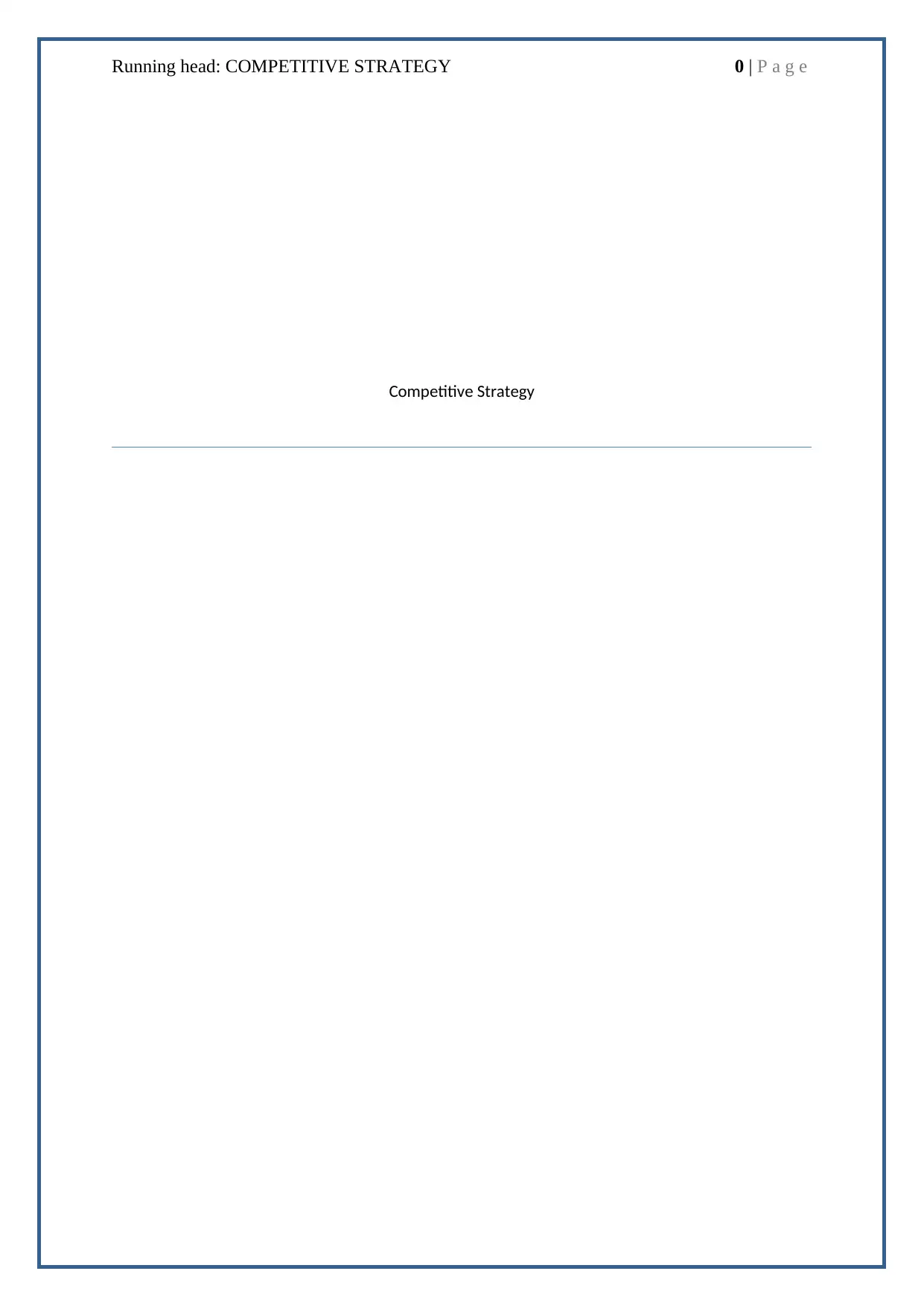
Running head: COMPETITIVE STRATEGY 0 | P a g e
Competitive Strategy
Competitive Strategy
Paraphrase This Document
Need a fresh take? Get an instant paraphrase of this document with our AI Paraphraser
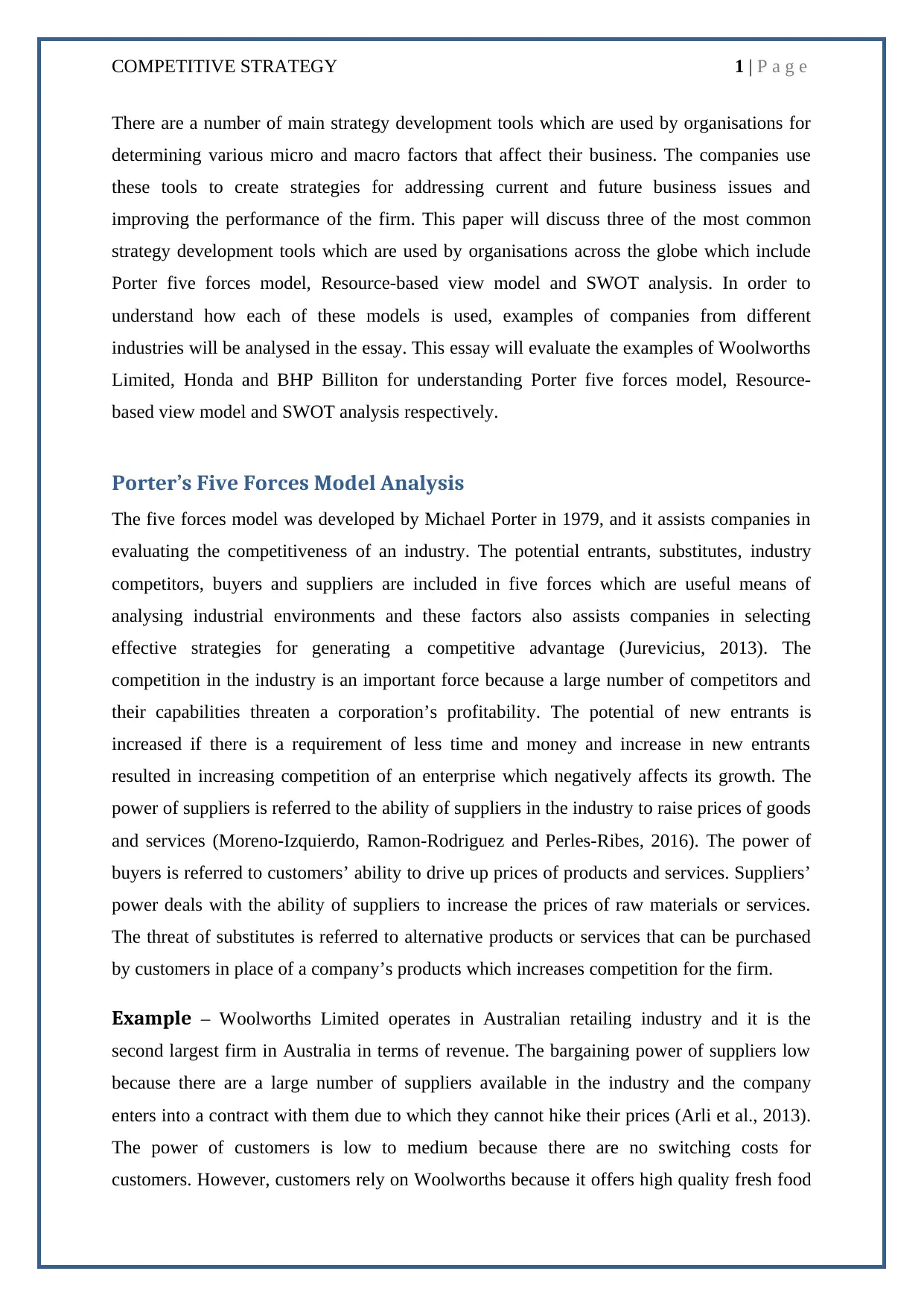
COMPETITIVE STRATEGY 1 | P a g e
There are a number of main strategy development tools which are used by organisations for
determining various micro and macro factors that affect their business. The companies use
these tools to create strategies for addressing current and future business issues and
improving the performance of the firm. This paper will discuss three of the most common
strategy development tools which are used by organisations across the globe which include
Porter five forces model, Resource-based view model and SWOT analysis. In order to
understand how each of these models is used, examples of companies from different
industries will be analysed in the essay. This essay will evaluate the examples of Woolworths
Limited, Honda and BHP Billiton for understanding Porter five forces model, Resource-
based view model and SWOT analysis respectively.
Porter’s Five Forces Model Analysis
The five forces model was developed by Michael Porter in 1979, and it assists companies in
evaluating the competitiveness of an industry. The potential entrants, substitutes, industry
competitors, buyers and suppliers are included in five forces which are useful means of
analysing industrial environments and these factors also assists companies in selecting
effective strategies for generating a competitive advantage (Jurevicius, 2013). The
competition in the industry is an important force because a large number of competitors and
their capabilities threaten a corporation’s profitability. The potential of new entrants is
increased if there is a requirement of less time and money and increase in new entrants
resulted in increasing competition of an enterprise which negatively affects its growth. The
power of suppliers is referred to the ability of suppliers in the industry to raise prices of goods
and services (Moreno-Izquierdo, Ramon-Rodriguez and Perles-Ribes, 2016). The power of
buyers is referred to customers’ ability to drive up prices of products and services. Suppliers’
power deals with the ability of suppliers to increase the prices of raw materials or services.
The threat of substitutes is referred to alternative products or services that can be purchased
by customers in place of a company’s products which increases competition for the firm.
Example – Woolworths Limited operates in Australian retailing industry and it is the
second largest firm in Australia in terms of revenue. The bargaining power of suppliers low
because there are a large number of suppliers available in the industry and the company
enters into a contract with them due to which they cannot hike their prices (Arli et al., 2013).
The power of customers is low to medium because there are no switching costs for
customers. However, customers rely on Woolworths because it offers high quality fresh food
There are a number of main strategy development tools which are used by organisations for
determining various micro and macro factors that affect their business. The companies use
these tools to create strategies for addressing current and future business issues and
improving the performance of the firm. This paper will discuss three of the most common
strategy development tools which are used by organisations across the globe which include
Porter five forces model, Resource-based view model and SWOT analysis. In order to
understand how each of these models is used, examples of companies from different
industries will be analysed in the essay. This essay will evaluate the examples of Woolworths
Limited, Honda and BHP Billiton for understanding Porter five forces model, Resource-
based view model and SWOT analysis respectively.
Porter’s Five Forces Model Analysis
The five forces model was developed by Michael Porter in 1979, and it assists companies in
evaluating the competitiveness of an industry. The potential entrants, substitutes, industry
competitors, buyers and suppliers are included in five forces which are useful means of
analysing industrial environments and these factors also assists companies in selecting
effective strategies for generating a competitive advantage (Jurevicius, 2013). The
competition in the industry is an important force because a large number of competitors and
their capabilities threaten a corporation’s profitability. The potential of new entrants is
increased if there is a requirement of less time and money and increase in new entrants
resulted in increasing competition of an enterprise which negatively affects its growth. The
power of suppliers is referred to the ability of suppliers in the industry to raise prices of goods
and services (Moreno-Izquierdo, Ramon-Rodriguez and Perles-Ribes, 2016). The power of
buyers is referred to customers’ ability to drive up prices of products and services. Suppliers’
power deals with the ability of suppliers to increase the prices of raw materials or services.
The threat of substitutes is referred to alternative products or services that can be purchased
by customers in place of a company’s products which increases competition for the firm.
Example – Woolworths Limited operates in Australian retailing industry and it is the
second largest firm in Australia in terms of revenue. The bargaining power of suppliers low
because there are a large number of suppliers available in the industry and the company
enters into a contract with them due to which they cannot hike their prices (Arli et al., 2013).
The power of customers is low to medium because there are no switching costs for
customers. However, customers rely on Woolworths because it offers high quality fresh food
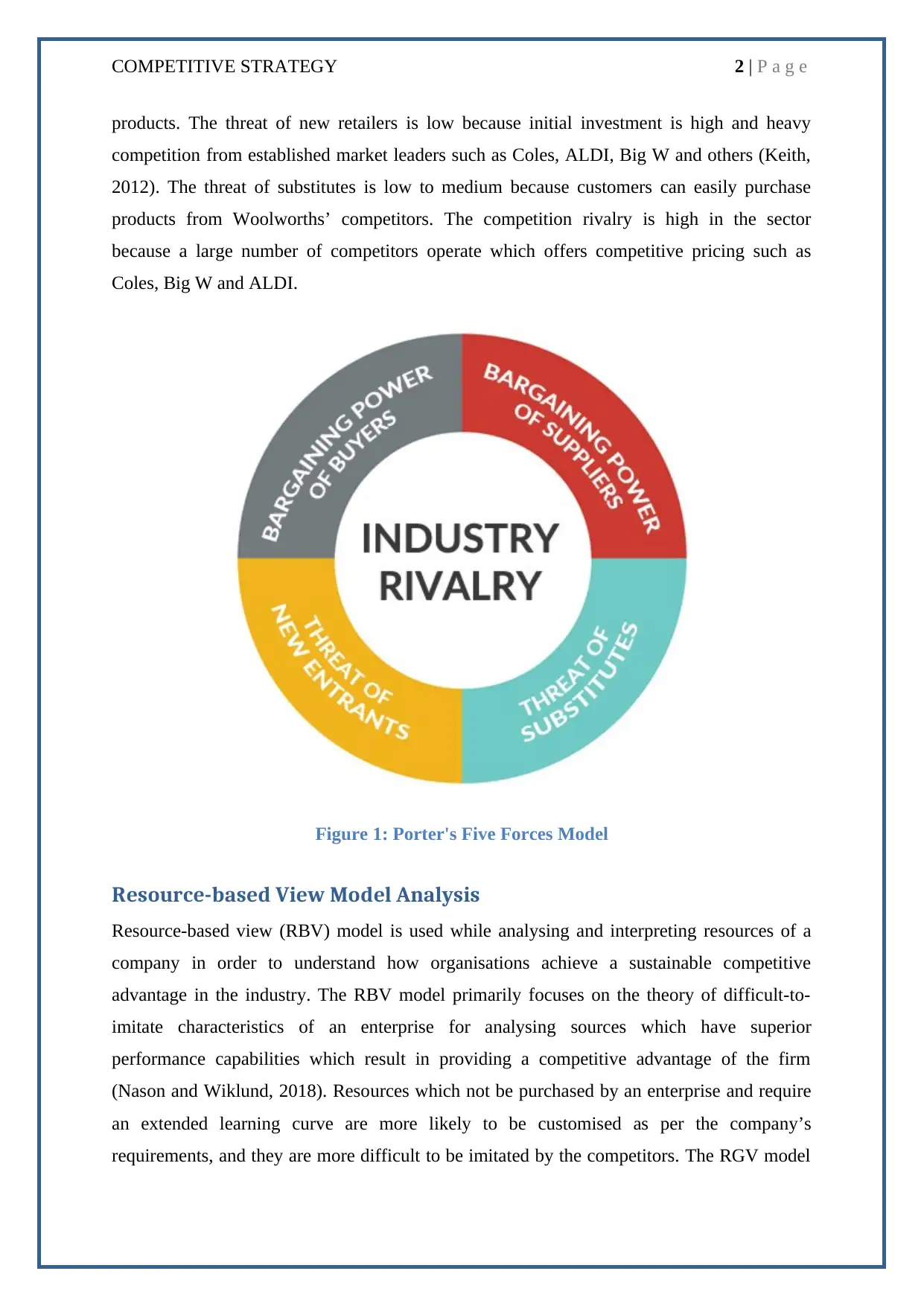
COMPETITIVE STRATEGY 2 | P a g e
products. The threat of new retailers is low because initial investment is high and heavy
competition from established market leaders such as Coles, ALDI, Big W and others (Keith,
2012). The threat of substitutes is low to medium because customers can easily purchase
products from Woolworths’ competitors. The competition rivalry is high in the sector
because a large number of competitors operate which offers competitive pricing such as
Coles, Big W and ALDI.
Figure 1: Porter's Five Forces Model
Resource-based View Model Analysis
Resource-based view (RBV) model is used while analysing and interpreting resources of a
company in order to understand how organisations achieve a sustainable competitive
advantage in the industry. The RBV model primarily focuses on the theory of difficult-to-
imitate characteristics of an enterprise for analysing sources which have superior
performance capabilities which result in providing a competitive advantage of the firm
(Nason and Wiklund, 2018). Resources which not be purchased by an enterprise and require
an extended learning curve are more likely to be customised as per the company’s
requirements, and they are more difficult to be imitated by the competitors. The RGV model
products. The threat of new retailers is low because initial investment is high and heavy
competition from established market leaders such as Coles, ALDI, Big W and others (Keith,
2012). The threat of substitutes is low to medium because customers can easily purchase
products from Woolworths’ competitors. The competition rivalry is high in the sector
because a large number of competitors operate which offers competitive pricing such as
Coles, Big W and ALDI.
Figure 1: Porter's Five Forces Model
Resource-based View Model Analysis
Resource-based view (RBV) model is used while analysing and interpreting resources of a
company in order to understand how organisations achieve a sustainable competitive
advantage in the industry. The RBV model primarily focuses on the theory of difficult-to-
imitate characteristics of an enterprise for analysing sources which have superior
performance capabilities which result in providing a competitive advantage of the firm
(Nason and Wiklund, 2018). Resources which not be purchased by an enterprise and require
an extended learning curve are more likely to be customised as per the company’s
requirements, and they are more difficult to be imitated by the competitors. The RGV model
⊘ This is a preview!⊘
Do you want full access?
Subscribe today to unlock all pages.

Trusted by 1+ million students worldwide
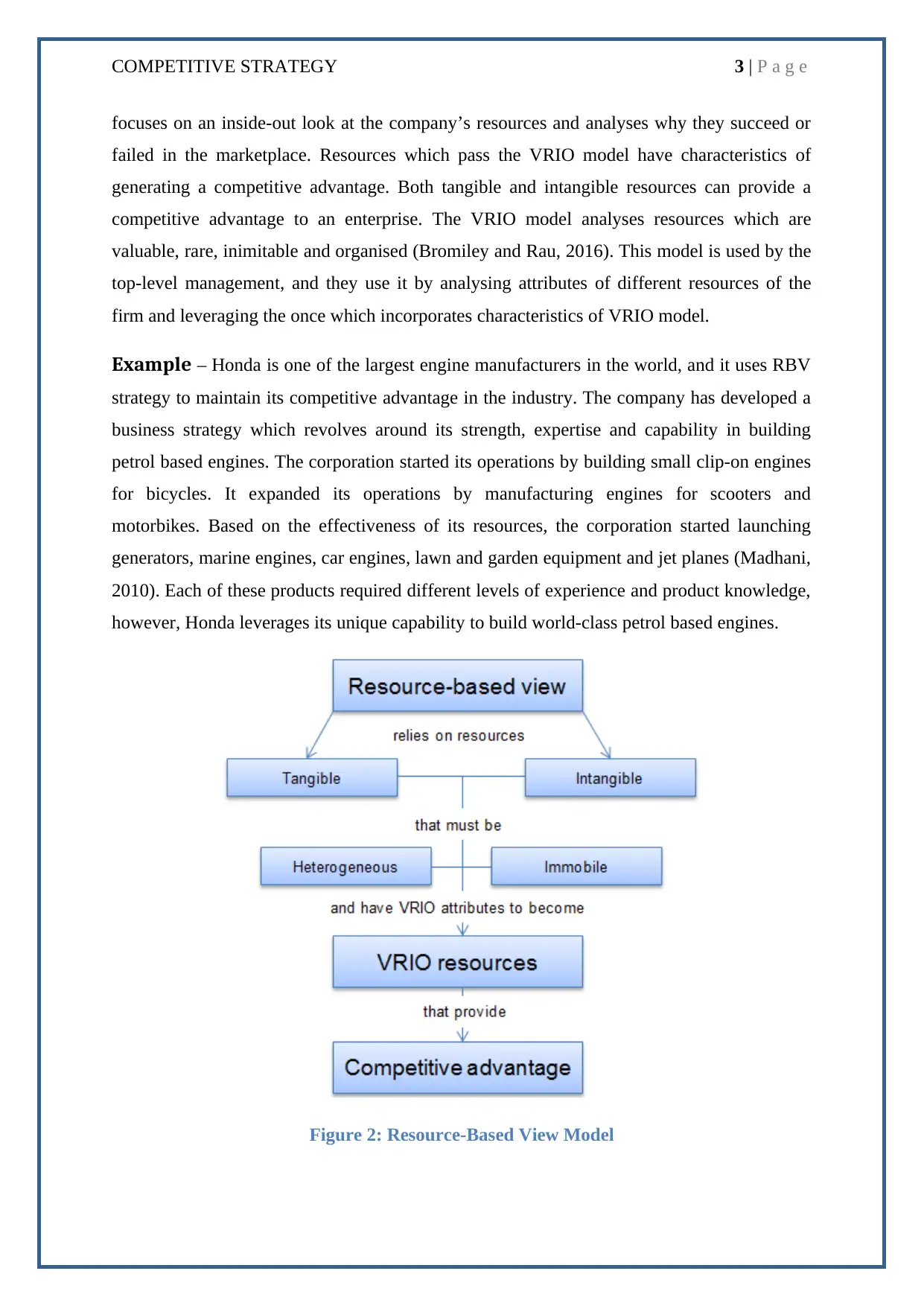
COMPETITIVE STRATEGY 3 | P a g e
focuses on an inside-out look at the company’s resources and analyses why they succeed or
failed in the marketplace. Resources which pass the VRIO model have characteristics of
generating a competitive advantage. Both tangible and intangible resources can provide a
competitive advantage to an enterprise. The VRIO model analyses resources which are
valuable, rare, inimitable and organised (Bromiley and Rau, 2016). This model is used by the
top-level management, and they use it by analysing attributes of different resources of the
firm and leveraging the once which incorporates characteristics of VRIO model.
Example – Honda is one of the largest engine manufacturers in the world, and it uses RBV
strategy to maintain its competitive advantage in the industry. The company has developed a
business strategy which revolves around its strength, expertise and capability in building
petrol based engines. The corporation started its operations by building small clip-on engines
for bicycles. It expanded its operations by manufacturing engines for scooters and
motorbikes. Based on the effectiveness of its resources, the corporation started launching
generators, marine engines, car engines, lawn and garden equipment and jet planes (Madhani,
2010). Each of these products required different levels of experience and product knowledge,
however, Honda leverages its unique capability to build world-class petrol based engines.
Figure 2: Resource-Based View Model
focuses on an inside-out look at the company’s resources and analyses why they succeed or
failed in the marketplace. Resources which pass the VRIO model have characteristics of
generating a competitive advantage. Both tangible and intangible resources can provide a
competitive advantage to an enterprise. The VRIO model analyses resources which are
valuable, rare, inimitable and organised (Bromiley and Rau, 2016). This model is used by the
top-level management, and they use it by analysing attributes of different resources of the
firm and leveraging the once which incorporates characteristics of VRIO model.
Example – Honda is one of the largest engine manufacturers in the world, and it uses RBV
strategy to maintain its competitive advantage in the industry. The company has developed a
business strategy which revolves around its strength, expertise and capability in building
petrol based engines. The corporation started its operations by building small clip-on engines
for bicycles. It expanded its operations by manufacturing engines for scooters and
motorbikes. Based on the effectiveness of its resources, the corporation started launching
generators, marine engines, car engines, lawn and garden equipment and jet planes (Madhani,
2010). Each of these products required different levels of experience and product knowledge,
however, Honda leverages its unique capability to build world-class petrol based engines.
Figure 2: Resource-Based View Model
Paraphrase This Document
Need a fresh take? Get an instant paraphrase of this document with our AI Paraphraser
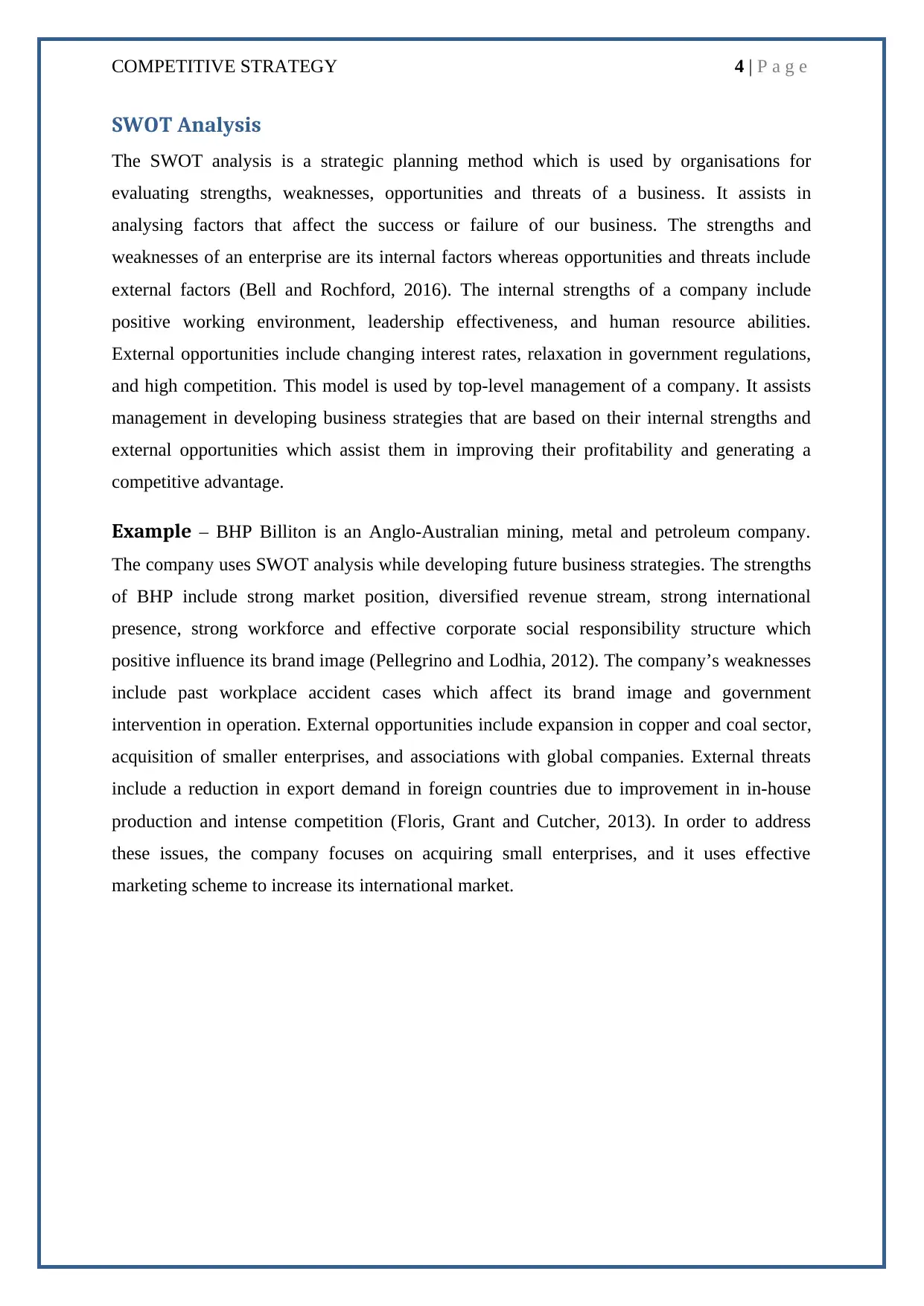
COMPETITIVE STRATEGY 4 | P a g e
SWOT Analysis
The SWOT analysis is a strategic planning method which is used by organisations for
evaluating strengths, weaknesses, opportunities and threats of a business. It assists in
analysing factors that affect the success or failure of our business. The strengths and
weaknesses of an enterprise are its internal factors whereas opportunities and threats include
external factors (Bell and Rochford, 2016). The internal strengths of a company include
positive working environment, leadership effectiveness, and human resource abilities.
External opportunities include changing interest rates, relaxation in government regulations,
and high competition. This model is used by top-level management of a company. It assists
management in developing business strategies that are based on their internal strengths and
external opportunities which assist them in improving their profitability and generating a
competitive advantage.
Example – BHP Billiton is an Anglo-Australian mining, metal and petroleum company.
The company uses SWOT analysis while developing future business strategies. The strengths
of BHP include strong market position, diversified revenue stream, strong international
presence, strong workforce and effective corporate social responsibility structure which
positive influence its brand image (Pellegrino and Lodhia, 2012). The company’s weaknesses
include past workplace accident cases which affect its brand image and government
intervention in operation. External opportunities include expansion in copper and coal sector,
acquisition of smaller enterprises, and associations with global companies. External threats
include a reduction in export demand in foreign countries due to improvement in in-house
production and intense competition (Floris, Grant and Cutcher, 2013). In order to address
these issues, the company focuses on acquiring small enterprises, and it uses effective
marketing scheme to increase its international market.
SWOT Analysis
The SWOT analysis is a strategic planning method which is used by organisations for
evaluating strengths, weaknesses, opportunities and threats of a business. It assists in
analysing factors that affect the success or failure of our business. The strengths and
weaknesses of an enterprise are its internal factors whereas opportunities and threats include
external factors (Bell and Rochford, 2016). The internal strengths of a company include
positive working environment, leadership effectiveness, and human resource abilities.
External opportunities include changing interest rates, relaxation in government regulations,
and high competition. This model is used by top-level management of a company. It assists
management in developing business strategies that are based on their internal strengths and
external opportunities which assist them in improving their profitability and generating a
competitive advantage.
Example – BHP Billiton is an Anglo-Australian mining, metal and petroleum company.
The company uses SWOT analysis while developing future business strategies. The strengths
of BHP include strong market position, diversified revenue stream, strong international
presence, strong workforce and effective corporate social responsibility structure which
positive influence its brand image (Pellegrino and Lodhia, 2012). The company’s weaknesses
include past workplace accident cases which affect its brand image and government
intervention in operation. External opportunities include expansion in copper and coal sector,
acquisition of smaller enterprises, and associations with global companies. External threats
include a reduction in export demand in foreign countries due to improvement in in-house
production and intense competition (Floris, Grant and Cutcher, 2013). In order to address
these issues, the company focuses on acquiring small enterprises, and it uses effective
marketing scheme to increase its international market.
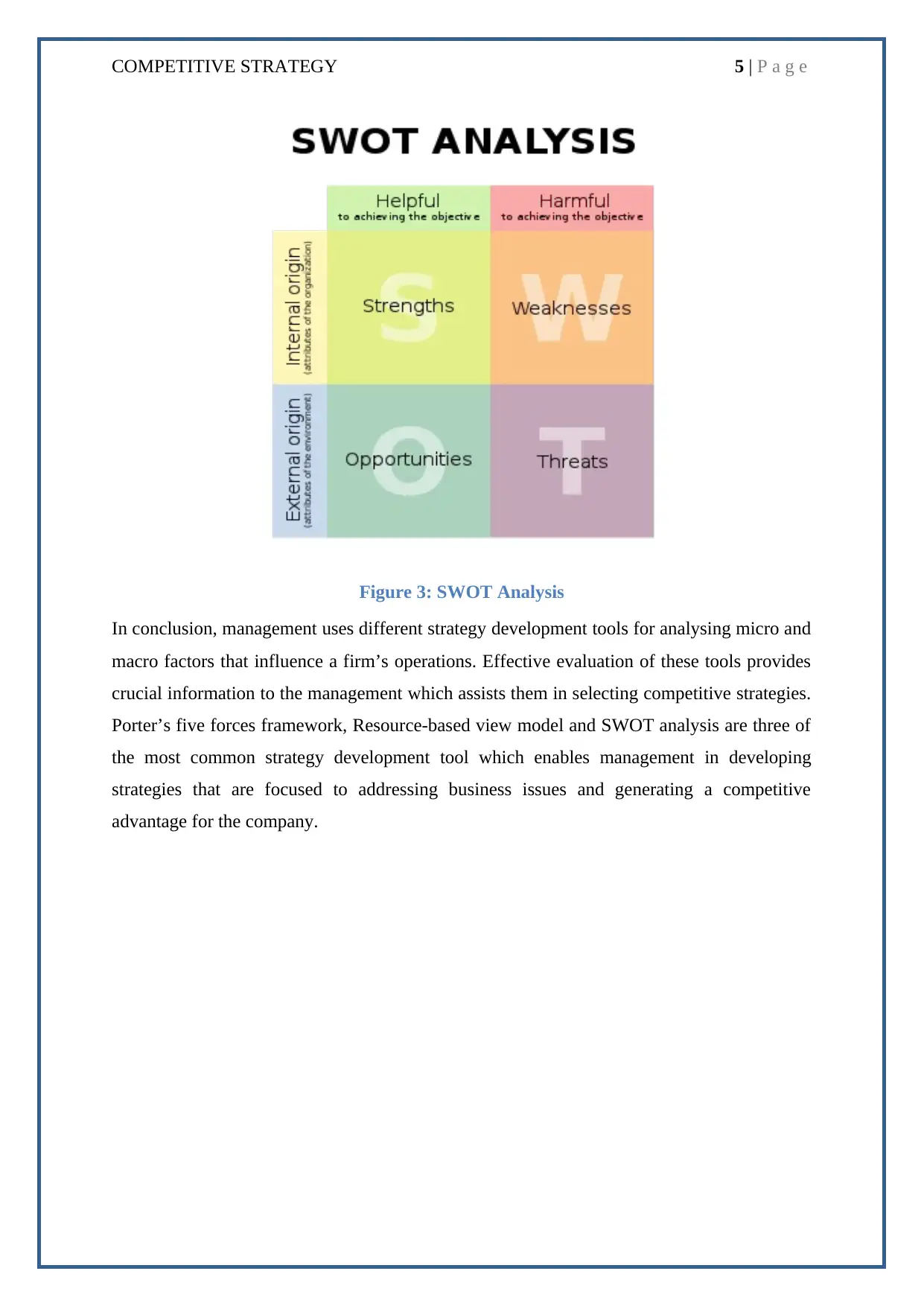
COMPETITIVE STRATEGY 5 | P a g e
Figure 3: SWOT Analysis
In conclusion, management uses different strategy development tools for analysing micro and
macro factors that influence a firm’s operations. Effective evaluation of these tools provides
crucial information to the management which assists them in selecting competitive strategies.
Porter’s five forces framework, Resource-based view model and SWOT analysis are three of
the most common strategy development tool which enables management in developing
strategies that are focused to addressing business issues and generating a competitive
advantage for the company.
Figure 3: SWOT Analysis
In conclusion, management uses different strategy development tools for analysing micro and
macro factors that influence a firm’s operations. Effective evaluation of these tools provides
crucial information to the management which assists them in selecting competitive strategies.
Porter’s five forces framework, Resource-based view model and SWOT analysis are three of
the most common strategy development tool which enables management in developing
strategies that are focused to addressing business issues and generating a competitive
advantage for the company.
⊘ This is a preview!⊘
Do you want full access?
Subscribe today to unlock all pages.

Trusted by 1+ million students worldwide
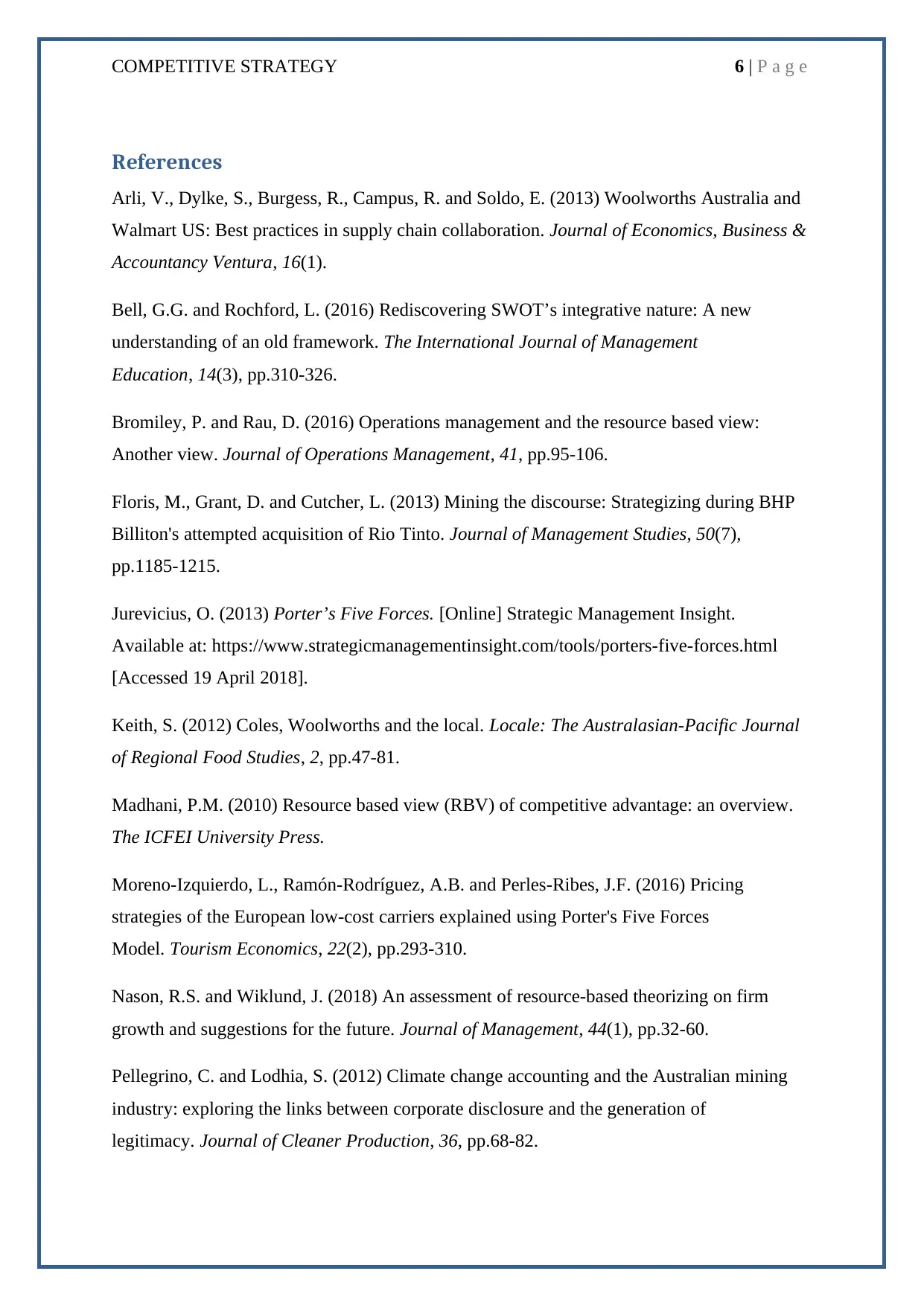
COMPETITIVE STRATEGY 6 | P a g e
References
Arli, V., Dylke, S., Burgess, R., Campus, R. and Soldo, E. (2013) Woolworths Australia and
Walmart US: Best practices in supply chain collaboration. Journal of Economics, Business &
Accountancy Ventura, 16(1).
Bell, G.G. and Rochford, L. (2016) Rediscovering SWOT’s integrative nature: A new
understanding of an old framework. The International Journal of Management
Education, 14(3), pp.310-326.
Bromiley, P. and Rau, D. (2016) Operations management and the resource based view:
Another view. Journal of Operations Management, 41, pp.95-106.
Floris, M., Grant, D. and Cutcher, L. (2013) Mining the discourse: Strategizing during BHP
Billiton's attempted acquisition of Rio Tinto. Journal of Management Studies, 50(7),
pp.1185-1215.
Jurevicius, O. (2013) Porter’s Five Forces. [Online] Strategic Management Insight.
Available at: https://www.strategicmanagementinsight.com/tools/porters-five-forces.html
[Accessed 19 April 2018].
Keith, S. (2012) Coles, Woolworths and the local. Locale: The Australasian-Pacific Journal
of Regional Food Studies, 2, pp.47-81.
Madhani, P.M. (2010) Resource based view (RBV) of competitive advantage: an overview.
The ICFEI University Press.
Moreno-Izquierdo, L., Ramón-Rodríguez, A.B. and Perles-Ribes, J.F. (2016) Pricing
strategies of the European low-cost carriers explained using Porter's Five Forces
Model. Tourism Economics, 22(2), pp.293-310.
Nason, R.S. and Wiklund, J. (2018) An assessment of resource-based theorizing on firm
growth and suggestions for the future. Journal of Management, 44(1), pp.32-60.
Pellegrino, C. and Lodhia, S. (2012) Climate change accounting and the Australian mining
industry: exploring the links between corporate disclosure and the generation of
legitimacy. Journal of Cleaner Production, 36, pp.68-82.
References
Arli, V., Dylke, S., Burgess, R., Campus, R. and Soldo, E. (2013) Woolworths Australia and
Walmart US: Best practices in supply chain collaboration. Journal of Economics, Business &
Accountancy Ventura, 16(1).
Bell, G.G. and Rochford, L. (2016) Rediscovering SWOT’s integrative nature: A new
understanding of an old framework. The International Journal of Management
Education, 14(3), pp.310-326.
Bromiley, P. and Rau, D. (2016) Operations management and the resource based view:
Another view. Journal of Operations Management, 41, pp.95-106.
Floris, M., Grant, D. and Cutcher, L. (2013) Mining the discourse: Strategizing during BHP
Billiton's attempted acquisition of Rio Tinto. Journal of Management Studies, 50(7),
pp.1185-1215.
Jurevicius, O. (2013) Porter’s Five Forces. [Online] Strategic Management Insight.
Available at: https://www.strategicmanagementinsight.com/tools/porters-five-forces.html
[Accessed 19 April 2018].
Keith, S. (2012) Coles, Woolworths and the local. Locale: The Australasian-Pacific Journal
of Regional Food Studies, 2, pp.47-81.
Madhani, P.M. (2010) Resource based view (RBV) of competitive advantage: an overview.
The ICFEI University Press.
Moreno-Izquierdo, L., Ramón-Rodríguez, A.B. and Perles-Ribes, J.F. (2016) Pricing
strategies of the European low-cost carriers explained using Porter's Five Forces
Model. Tourism Economics, 22(2), pp.293-310.
Nason, R.S. and Wiklund, J. (2018) An assessment of resource-based theorizing on firm
growth and suggestions for the future. Journal of Management, 44(1), pp.32-60.
Pellegrino, C. and Lodhia, S. (2012) Climate change accounting and the Australian mining
industry: exploring the links between corporate disclosure and the generation of
legitimacy. Journal of Cleaner Production, 36, pp.68-82.
Paraphrase This Document
Need a fresh take? Get an instant paraphrase of this document with our AI Paraphraser
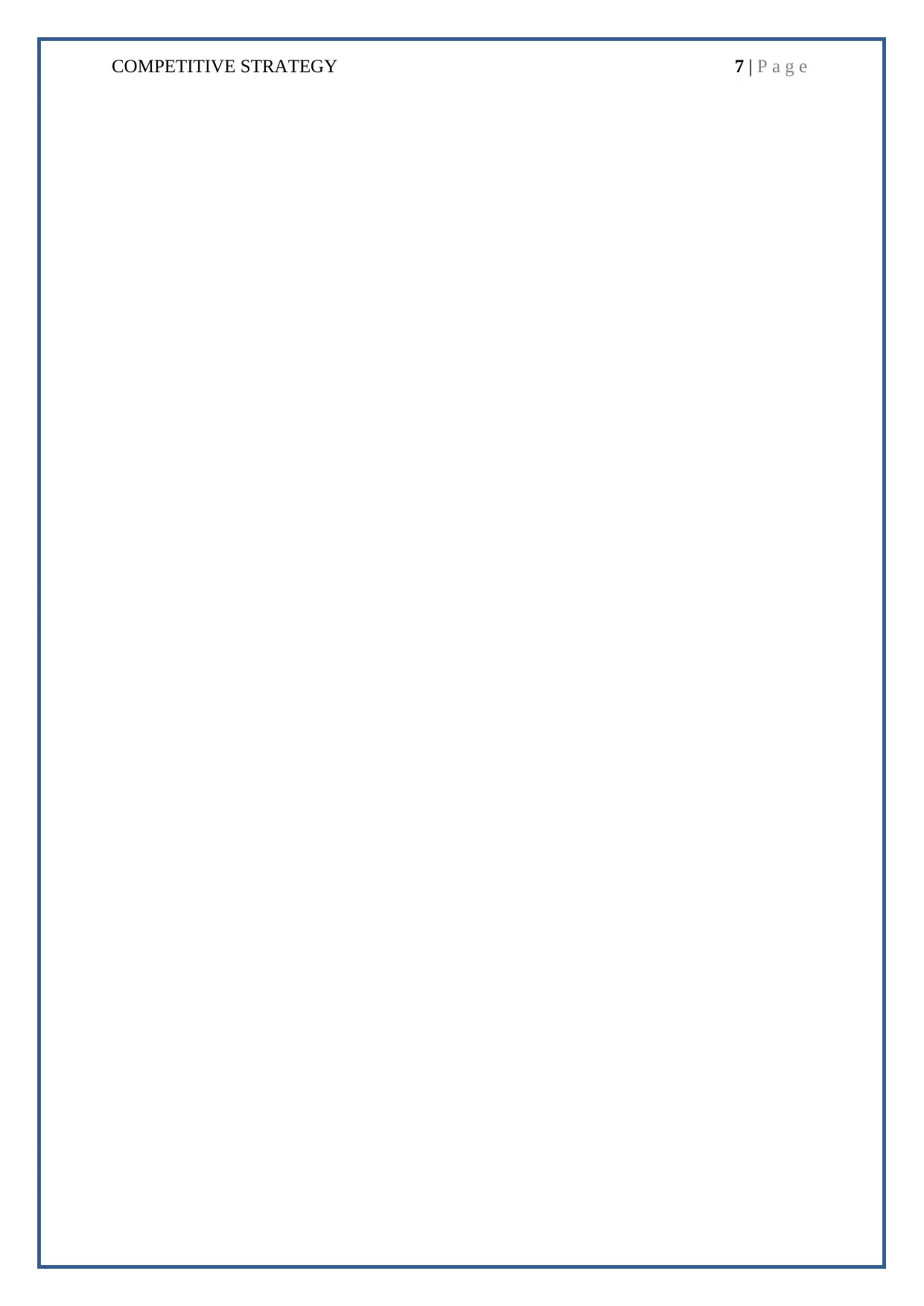
COMPETITIVE STRATEGY 7 | P a g e
1 out of 8
Related Documents
Your All-in-One AI-Powered Toolkit for Academic Success.
+13062052269
info@desklib.com
Available 24*7 on WhatsApp / Email
![[object Object]](/_next/static/media/star-bottom.7253800d.svg)
Unlock your academic potential
Copyright © 2020–2025 A2Z Services. All Rights Reserved. Developed and managed by ZUCOL.





